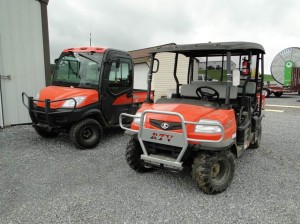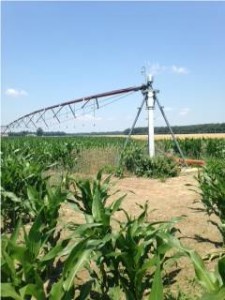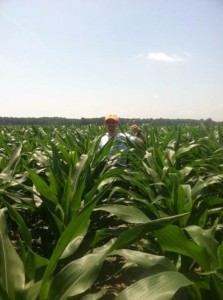This summer I work with three other interns at Pioneer New Holland. Two of them are majoring in agriculture, one at Penn State University and another at Delaware Valley College which is also in Pennsylvania. The fourth person is actually a temporary employee that they hired on full time for the summer. Whatever task we may be assigned to do for a particular day or week, we generally all work together or at least in pairs. This is a nice change from last year when I was the sole new person at my summer job. We often run around the “home research farm” on a Kubota RTV like the ones pictured. We have fun as we take stand counts, hoe volunteer corn, or put stakes out.
Taking stand counts involves counting the number of healthy looking plants in a given plot that are likely to mature and yield adequately. We walk through the field and count the plants using counting sticks, reporting the number of plants to one of the research assistants following us. She records our numbers in a data collection program on an I-Pad. We go down through the field counting and shouting off numbers so the plant breeders know which plots have adequate stands and which plots do not. Included are some shots of the crew taking stand counts on the Delmarva Peninsula near Salisbury, MD. There are two things on the Delmarva Peninsula which we do not have much of in Lancaster County: irrigation rigs and beach-sand soil. Also, while the corn in Lancaster was knee high in mid-June, it was chest high down there.
At Pioneer’s research station in New Holland, there are two plant breeders and one plant pathologist. These three people are in charge of all the experiments and studies at the station. They run experiments in different corn plots trying to improve traits in both varieties of corn grain and corn silage. Helping the breeders maintain their experiments are about half a dozen research assistants that oversee the day to day tasks of collecting data and maintaining the plots. There are also several guys that work out in the equipment shop, operating and maintaining all field equipment and vehicles, as well as keeping the fields and ground up-kept. This makes up the daily working crew at the experiment station in addition to some administrative staff.
At this research station, the staff are currently working to improve yield, disease resistance, nutritional quality, and stand-ability including stalk and root strength. Two big diseases that are prevalent in corn in the north-east that they are working to improve resistance against are Northern Leaf Blight and Grey Leaf Spot. Also, as Pennsylvania and New York make up a large dairy region in the north-east, trying to increase the nutritional quality and digestibility of corn silage is an important aim for at least one breeder at this station. A relatively new corn silage variety called “BMR” standing for Brown Mid-Rib is a type of corn that has less lignin, making it more digestible to the cow. The other interns and I can easily identify this out in the field as the mid-ribs of the leaves are indeed brown.




Speak Your Mind